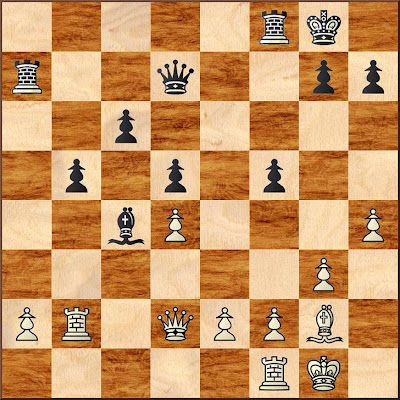I started the game with a simple plan to employ a slightly uncommon move order in hopes of denying him the comfortable position that he sought. Then, over the board, I concocted a plan to cramp his game. IM John Donaldson told me after the game that he thought I had a nice position.
Stripes,James (1949) -- Krasin,Jeremy (1904) [A85]
Collyer Memorial Spokane (4), 24.02.2013
1.Nf3 f5 2.d4 Nf6 3.Bg5 e6 4.c4 Be7 5.Nc3 c6
White to move
The strongest players who have reached this position had a long draw:
5...0–0 6.e3 b6 7.Bd3 Bb7 8.0–0 Nc6 9.Rc1 h6 10.Bh4 Ne4 11.Bxe7 Nxe7 12.Bxe4 fxe4 13.Nd2 d5 14.Qg4 Rf6 15.Ne2 Qd6 16.Qg3 Qxg3 17.hxg3 c6 18.b4 Nf5 19.a4 Nd6 20.c5 Nf7 21.b5 e5 22.Nb3 Rb8 23.Rc2 Bc8 24.Nc3 Bd7 25.Rd1 Re6 26.Rdc1 Ree8 27.cxb6 axb6 28.bxc6 Bxc6 29.dxe5 Nxe5 30.Nd4 Bb7 31.Ncb5 Nc4 32.Rc3 Rbc8 33.Rb1 Ba6 34.Na3 Nd2 35.Rxc8 Rxc8 36.Rxb6 Rc1+ 37.Kh2 Bd3 38.Rb2 Nc4 39.Rb8+ Kh7 40.Nab5 Ne5 41.g4 Nxg4+ 42.Kg3 Nf6 43.Nd6 Rh1 44.Ne6 Kg6 45.Nf4+ Kh7 46.Rf8 Bf1 47.a5 h5 48.Nf5 Bb5 49.Rf7 h4+ 50.Nxh4 Kg8 51.Rb7 g5 52.Nf5 gxf4+ 53.Kxf4 Bc4 54.Rb6 Kf7 55.a6 Nd7 56.Rc6 Ra1 57.Nd6+ Ke7 58.Nxc4 dxc4 59.Rxc4 Rxa6 60.Rxe4+ Kf7 61.g4 Nc5 62.Rc4 Ra4 63.Rxa4 Nxa4 64.Kf5 Nb2 65.f4 Nc4 66.e4 Ne3+ 67.Kg5 Ke6 68.f5+ Ke5 69.f6 Nxg4 ½–½ Nogueiras Santiago,J (2575) -- Jussupow,A (2610) Rotterdam 1989
6.c5 Nd5N
The two other games that reaced the position after my 6.c5 were between players with ratings close to those of Jeremy and I (mere patzers).
7.Bxe7 Qxe7 8.Qc2 b6 9.Nxd5 exd5
White to move
10.b4
I thought about 10.Qxf5, which might have led to 10...bxc5 11.Qh5+ g6 12.Qe5 Qxe5 13.dxe5, but something in Black's mass of center pawns looked menacing to me. Besides, I thought that I could keep Black severely cramped.
10...0–0 11.g3
This move was part of a long-term plan to render Black's light-squared bishop an impotent piece. This plan failed in the end. Maybe 11.e3 was sensible.
11...Ba6 12.Rb1
Perhaps 12.Ne5 was better here.
12...Bc4
Black's position is cramped, but his bishop has a strong forward outpost. My idea that I could play around the light-squares controlled by this bishop was a risky decision.
White to move
13.Rb2
13.Ne5 b5 14.Bg2 d6 15.Nxc4 bxc4 16.b5 may be equal. It is hard to find the correct equalizing moves while laboring under the belief that one has an advantage.
13...b5 14.Ne5?! Now, this natural looking move wastes time
14.Bh3 was better
14...a5
Black has the advantage
15.bxa5 Rxa5
White to move
16.Qd2
16.Bh3 was still better
16...Ra7 17.h4 d6 18.cxd6 Qxd6 19.Bg2
19.Nxc4 bxc4 20.Bh3 and Black has a clear advantage
19...Nd7 20.Nxd7 Qxd7–+ 21.0–0
Black to move
21...Rfa8
21...f4 was the correct move. My opponent mentioned it after the game as something that he had considered. Such a move is natural for one who plays the Dutch Defense.
22.Ra1 Qe7 23.Bf3 Ra3 24.Kg2 R8a4 25.Qf4 g6
Somehow Black has escaped the chains and used them to wrap up his would be captor.
White to move
26.h5!
26.Qb8+! Kg7 27.h5 Ra8!
27...Rxa2?? would be lead to 28.Rbxa2 Rxa2 29.Rxa2 Bxa2 30.Qa8 Bc4 31.Qxc6=
28.Qf4 and Black retains a clear advantage
26...Rxa2 27.Rbxa2 Rxa2
White to move
I was conscious when I played 25.Qf4 that my real target was the pawn on c6. When the critical position was reached, however, I lost sight of this goal and played the wrong sequence for my planned moves. I correctly assessed that my king was in the square of the b-pawn, but with a bishop guarding the promotion square, it was necessary to catch the pawn on b2.
28.Qb8+??
28.Rxa2! Bxa2 29.Qb8+ Kg7 (29...Qf8? 30.Qb7 and White may have a slight advantage) 30.Qa8= winning the c-pawn with a fork.
28...Qf8 29.Qxf8+ Kxf8 30.Rxa2 Bxa2 31.hxg6 hxg6 32.Kf1 b4 33.Ke1 b3 0–1
This was my first loss in the Collyer Memorial since 2008, when I lost to an expert. I drew that expert in 2009, did not play in 2010 due to taking a high school team to state the same weekend, and in 2011 had to work Saturday and played only one game on Sunday. In 2012, I won all my games and placed second in the event.
In the final round, Krasin had Black against Donaldson. The International Master prevailed against his Dutch.



















I don't think the Dutch is as effective against 1. Nf3, as the move-order gives White more flexibility. Bg5 can also be annoying to deal with.
ReplyDeleteI would argue that this game isn't fully a Stonewall (although it's closest to that) as the characteristic pawn formation never appears (...d5 isn't played, although the e-pawn occupies the square). Black's pawn structure is in fact rather awful after move 9. Interesting game, thanks for the annotations.
I played 6.c5 to prevent the Stonewall, which was his intent. Perhaps I could have made that more clear. In my two games against Krasin's Dutch, I have prevented the Stonewall. I have seen him play it against others, including the next round when he played John Donaldson (another game that began 1.Nf3).
Delete